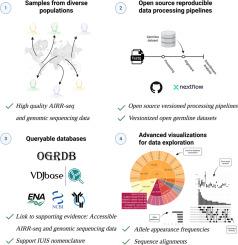未来建立免疫球蛋白和T细胞受体基因数据库
引用次数: 0
摘要
免疫球蛋白(IG)和T细胞受体(TR)基因的遗传数据库已经从小型目录发展成为支持免疫遗传学研究的关键资源。准确的注释能够分析曲目多样性,体细胞超突变,克隆关系和谱系发展。高通量全库测序和长读基因组学的最新进展现在允许在种群和物种之间前所未有地发现生殖系变异,但它们也暴露了现有资源的局限性。本文讨论了IG/TR数据库的历史演变,强调了不断变化的数据格局所带来的挑战和机遇,并概述了构建整合基因组和表达数据、支持种群多样性并与不断发展的命名框架保持一致的未来数据库的策略。增强生殖系资源对于准确注释、可重复性研究以及下一代免疫学发现和临床翻译至关重要。本文章由计算机程序翻译,如有差异,请以英文原文为准。

Building immunoglobulin and T cell receptor gene databases for the future
Genetic databases for immunoglobulin (IG) and T cell receptor (TR) genes have evolved from small catalogs to critical resources underpinning immunogenetic research. Accurate annotation enables the analysis of repertoire diversity, somatic hypermutation, clonal relationships, and lineage development. Recent advances in high-throughput repertoire sequencing and long-read genomics now allow for unprecedented discovery of germline variation across populations and species, but they also expose limitations of existing resources. Here, we discuss the historical evolution of IG/TR databases, highlight the challenges and opportunities presented by changing data landscapes, and outline strategies for building future databases that integrate genomic and expression data, support population diversity, and align with evolving nomenclature frameworks. Enhanced germline resources will be essential for accurate annotation, reproducible research, and the next generation of immunological discovery and clinical translation.
求助全文
通过发布文献求助,成功后即可免费获取论文全文。
去求助
来源期刊

Immunoinformatics (Amsterdam, Netherlands)
Immunology, Computer Science Applications
自引率
0.00%
发文量
0
审稿时长
60 days
 求助内容:
求助内容: 应助结果提醒方式:
应助结果提醒方式:


